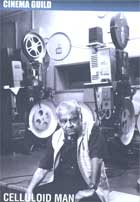
Celluloid Man: A Film on P.K. Nair 2012
Distributed by Cinema Guild, 115 West 30th Street, Suite 800, New York, NY 10001; 212-685-6242
Produced by Dungarpur Films
Directed by Shivendra Singh Dungarpur
DVD, color and b&w, 164 min.
Jr. High - General Adult
Archives, Films
Date Entered: 07/18/2014
Reviewed by Kathleen Spring, Nicholson Library, Linfield College, McMinnville, ORShivendra Singh Dungarpur’s film Celluloid Man traces the story of P.K. Nair, the founder and former director of the National Film Archive of India. Nair was a custodian and archivist of Indian cinema who worked with one objective in mind – to preserve Indian film heritage. Nair saw films as part of cultural history and believed people understand the world (and other people) better because of them; as such, Nair understood he was preserving memory as well as cinema. Celluloid Man is as much about Nair’s career as it is about the history of Indian cinema, and as one interviewee asserts in the film, “India has a rich past but a very poor history.”
One of the strengths of Celluloid Man is its use of archival footage from a variety of early Indian films, both silent and “talkies.” The collection which Nair helped to amass for the National Film Archive of India is extensive; yet, preservation has taken a back seat since his retirement, and the film serves as a good reminder of what can happen when cultural objects are neglected.
Unfortunately, the film has several drawbacks. Subtitles are used heavily throughout the film for both heavily-accented English speakers and those speaking in other languages; however, there are occasional errors, and the subtitles can be difficult to read, depending on the background. Additionally, the film suffers from a lack of clear narrative structure and would have benefitted from some judicious editing to trim the length. Despite these flaws, there is value here, although many academic libraries may opt to pass unless they are supporting curricula in film history or archival studies.
In English, Hindi, Kannada, Bengali, and Malayalam, with English subtitles.